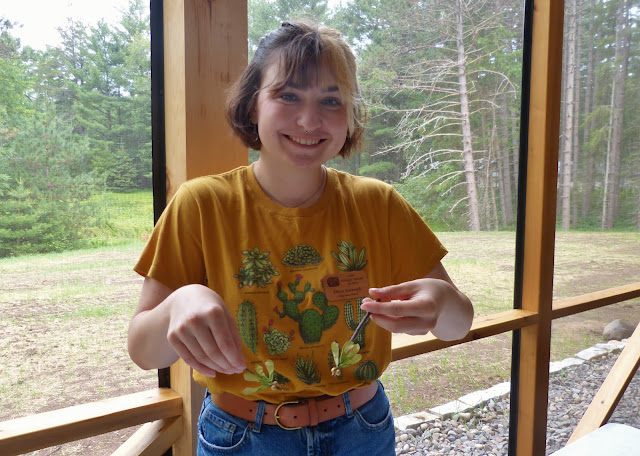Intern Spotlight: Olivia Rataezyk
I've had the pleasure of working alongside a handful of superb collections volunteers and interns over the past few years. Each contribute invaluable insight and energy into the work we do at the Museum. This week, we'll learn a bit more about a young museum professional deeply invested in collections work - Olivia. She also happens to be one of our new summer interns!
In your own words, tell us about your work so far at the Museum and what you're excited about working with or learning in the collection.
I’m
up here for the summer from Seattle, WA serving as a Naturalist Intern. As of
my first two weeks, my work has been quite varied; I’ve done a little bit of a
wide variety of things in the Museum, from working on future specimen of the
month displays to leading Junior Naturalists with my fellow intern Cade.
Additionally, my first week here was spent doing the Wisconsin Master
Naturalist course and becoming acquainted with the Northwoods, which was super
cool! As an intern I’m both tasked with daily upkeep and given the chance to explore
some of my own interests, time permitting. For example, I came into this
position with an interest in museum collections and a little bit of experience
with preparing study specimens. As a result, I’m being given the chance to
learn about museum collections through physically working with them. I’m
excited to see how museums use their collections daily and to work with the
Museum’s collection to educate the public through Junior Naturalists and
displays.
Can you describe a favorite museum specimen, display, or exhibit? It doesn't have to be from the Cable Natural History Museum!
My
favorite displays are always the ornithological cases in natural history
museums. When the display is focused on birds that are or were found in the
area, I love seeing native species prepared with so much care and appreciate
the focus on educating visitors about what they can see right in the area! If
there are nonnative species included, I enjoy the short trip around the world
that they provide – it’s special to learn about animals that I would otherwise
never see. Similarly, I think that displays are especially fascinating when
they include extinct species, since then they provide the opportunity for
visitors to learn about human interactions with animals and how they can harm
ecosystems. Learning about extinct species in museums certainly increased my
interest in conservation, at least. Out here in Cable, I really appreciate the
Passenger Pigeon display. Their story is heartbreaking and I’m glad that
visitors get to see an example of what used to be such a common bird and to
learn about their history.
What are some of your hobbies/interests involving the natural world? What would you like to learn or what new skills would you like to develop?
I
have been interested in birds for most of my life, and I now study biology in
college, so I feel it’s safe to say that I’m fairly interested in the natural
world through a fairly scientific lens. However, I’m hoping to develop my
skills in interpretation and education this summer, since I often find myself
talking about biology and the natural world in ways that mainly make sense to
me. Part of a successful scientific education, in my opinion, is learning how
to break the information you have learned down in an interesting and informative
manner so that your writing can be easily read and understood by others. I also
enjoy just being out in nature – I love hiking and birdwatching on the trails
around my college campus, especially with friends, and I would like to be able
to talk about what we see in a more exciting way. Beyond communication, I hope
to improve my skills with the more behind-the-scenes museum work, especially
anything having to do with specimen preparation and/or upkeep and the creation
of our displays.
What's one thing you wish everyone knew about the Museum or our collection?
I
wish everyone knew that the Museum’s collection is very much alive (in a sense)
and in constant use. Specimens are regularly being brought out to show off and
talk about in Junior Naturalists or swapped into and out of displays; every
specimen serves a purpose and many of them find that purpose outside of the
collections room itself or even the physical museum. Our collection is
additionally growing and changing quite often.
Thanks, Olivia!
